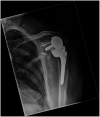The management of infected shoulder arthroplasty by two-stage revision
- PMID: 33343718
- PMCID: PMC7726183
- DOI: 10.1177/1758573219841057
The management of infected shoulder arthroplasty by two-stage revision
Abstract
Background: There remains no gold standard management for deep shoulder periprosthetic joint infection (PJI). This case series aims to present our experience of two-stage revision arthroplasty, including eradication of infection and reoperation rates.
Methods: We retrospectively reviewed patients undergoing revision arthroplasty for shoulder PJI between 2006 and 2015. Cases were confirmed using Musculoskeletal Infection Society (MSIS) and American Academy of Orthopaedic Surgeons (AAOS) guidelines. TSA removal, debridement and irrigation preceded antibiotic-loaded cement spacer insertion and a minimum of six weeks intravenous antibiotics. Reimplantation was performed as a second stage following a negative aspirate.
Results: Twenty-eight patients underwent a first stage procedure (mean age 69 years; 16 male, 12 female). Propionibacterium acnes, Methicillin-sensitive Staphylococcus aureus, Coagulase-negative Staphylococcus and Staphylococcus epidermidis were the commonest microorganisms cultured. Five cases had mixed growths and six cases provided no growth. Three patients did not proceed to a second stage. Twenty-five patients underwent reimplantation (mean interval 6.7 months), with 80% remaining infection-free (mean follow-up 38.3 months).
Discussion: Managing complex and late presentation shoulder PJI with two-stage revision is associated with high rates of infection eradication (80%). In the absence of a management consensus, our experience supports two-stage revision arthroplasty for eradicating infection in this complex patient group.
Keywords: infection eradication; periprosthetic joint infection; reimplantation; revision shoulder arthroplasty; total shoulder arthroplasty; total shoulder replacement; two-stage revision arthroplasty.
© 2019 The British Elbow & Shoulder Society.
Conflict of interest statement
Declaration of Conflicting Interests: The author(s) declared no potential conflicts of interest with respect to the research, authorship, and/or publication of this article.
Figures
References
-
- Updegrove GF, Armstrong AD, Kim HM. Preoperative and intraoperative infection workup in apparently aseptic revision shoulder arthroplasty. J Shoulder Elbow Surg 2015; 24: 491–500. - PubMed
-
- Dines JS, Fealy S, Strauss EJ, et al. Outcomes analysis of revision total shoulder replacement. J Bone Joint Surg Am 2006; 88: 1494–1500. - PubMed
-
- Bohsali KI, Wirth MA, Rockwood CA. Complications of total shoulder arthroplasty. J Bone Joint Surg Am 2006; 88: 2279–2292. - PubMed
-
- Braman JP, Sprague M, Bishop J, et al. The outcome of resection shoulder arthroplasty for recalcitrant shoulder infections. J Shoulder Elbow Surg 2006; 15: 549–553. - PubMed
LinkOut - more resources
Full Text Sources
Research Materials


